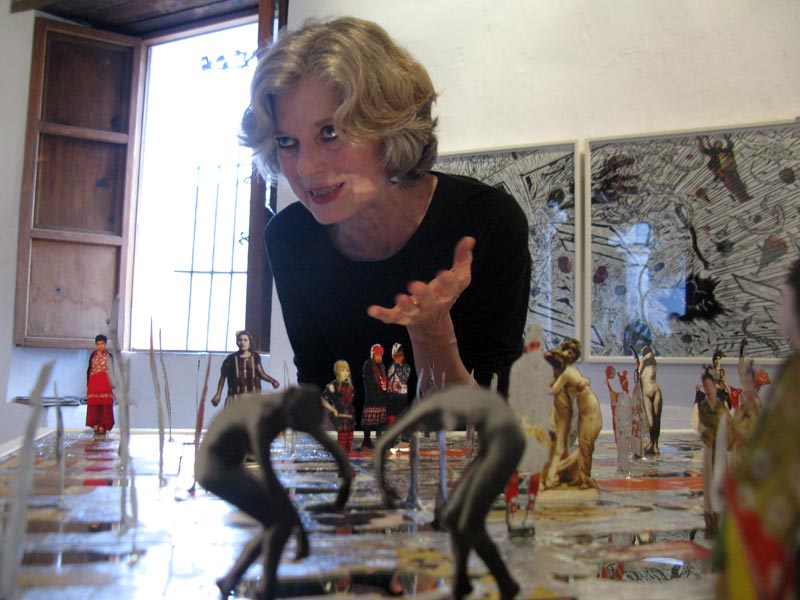
Llamas
Los libros que forman mi participación en la exposición de libros de artista, junio a agosto en la Biblioteca Lerdo de Tejada en la ciudad de México, tiene su génesis en dos proyectos que me ocupan desde hace un par de años: Elsewhere/Otherness y Mujeres, fuego y objetos peligrosos. Los lectores de ese blog ya están familiarizados con ellos… pero recalco un poco de qué se tratan:
El primer proyecto (Elsewhere/Otherness) tiene que ver con mi tendencia incontrolable de expresarme por medio de la otredad, manifestada particularmente con una fascinación con la estética de Asia. El segundo nació con mis archivos de personas en llamas y volcanes, que colecciono desde hace años, que trabajé en la serie Inmolación, y amplié los conceptos de Inmolación con el hallazgo del dato del idioma de una tribu de aborígenes de Australia que maneja varios géneros, uno de ellos caracterizado por la inclusión de mujeres, fuego y objetos peligrosos. Apropié la frase, que abarca varios asuntos cercanos a mi iconografía, y desarrollé una exposición trabajando con material (imágenes) bajado del internet como resultado de meter en “búsqueda” las palabras “mujer, fuego” y “objetos peligrosos”. La mayor parte de la exposición, como la obra en estos libros de artista, está basada en la técnica de transferencia o transfer: la manipulación de una imagen previa con photoshop, fotocopia, y su traslado con solvente a un papel nuevo.
Me sobró algo de material de proyecto: la cara de una mujer hindú que prendió fuego a su marido, unas casas en llamas, la tienda de mujeres de una boda paquistaní, en llamas por un asunto de honor de hombres asociados con las atrapadas adentro, y la imagen de una kurda guerrillera con su metralleta, frente a una fogata (esta última es la única vez que se me unieron en una imagen lo representado por cada una de las tres palabras: una mujer, fuego y un objeto peligroso). Juntas, las imágenes forman una secuencia que habla de la pérdida de lugar- el abandono forzoso de lo seguro por lo incierto. Así salió el libro De la intemperie.

FLAMES
The first project, (Elsewhere/Otherness) has to do with my uncontrollable tendency to express myself by means of otherness- something I am not- manifested particularly in a fascination with the esthetics of Asia.
The second had its origin in my archives of people in flames and volcanoes, which I have been collecting for some time and developed into the series Immolation, and was amplified to its present form with my discovery that in the language of a tribe of Aboriginal people in Australia, one of their various genders is characterized by the inclusion of women, fire and dangerous objects. I appropriated the phrase, which covers several matters central to my own iconography, and put together a show working with material downloaded from the internet as a result of putting into search the words “women, fire” or “dangerous objects”. Most of that show (as well as the artist’s books pictured here) was elaborated using the technique of transfer: the manipulation of a given image with photoshop and photocopies, and its transfer to a new surface (usually paper) by means of solvent.
I had some material left over from the project: the face of a Hindu woman who had set fire to her husband, a few houses in flames, the women’s tent in a Pakistan wedding, set afire to settle a matter of honor of men associated with the women within, and the image of a Kurdish female guerrilla fighter before a campfire (this last is the only image I found that united in the same scene that represented by the three key words: a woman, a fire and a dangerous object). Together the images form a sequence that addresses the loss of place of origin- the forced abandonment of the certain for the uncertain. The result is the work That which is transitory.



Otro caso de pérdida de lugar es narrado en el libro La cola del dragón. Las imágenes documentan el autoinmolación de una mujer china en su azotea, después de recibir la noticia de su inminente desalojo.
Another case of loss of place of origin is narrated in the artist’s book The Tail of the Dragon. The images document the auto immolation of a Chinese woman on her rooftop, after having received an eviction notice.





El libro El claustro está relacionado con el proyecto Elsewhere/Otherness. Trabajando con una postal de una monja japonesa fotografiada por el italiano Felice Beato, fotógrafo viajero en el Japón decimonónico, y una tarjeta estereoscópica antigua donde se repite una escena de lotos flotando, construí un encierro. Las llamas están contenidas esta vez: atrás de la imagen transparentada de lotos se esconde otra, de un incendio. Los hilos de la costura sirven para sugerir la reclusión forzosa de una monja, además de su pelo escondido, que sale, como sangre debajo de una puerta, de los confines de su encierro.



The book The Convent is related to the project Elsewhere/Otherness. Working with a postcard of a Japanese nun, photographed by the Italian Felice Beato, a photographer who travelled extensively in 19th century Japan, and with an antique stereoscopic card containing the repeated image of a scene of floating lotus, I constructed an enclosure. The flames are contained this time: behind the transparented image of floating lotus I have hidden another, of a fire. The threads of stitching across the nun’s image suggest her forced reclusion, and also her hidden hair which flows out, like blood under a door, from the confines of her enclosure.


Además de la mía la exposición incluye obra de Magali Lara, Pilar Bordes, Martha Hellion, Patricia Lagarde, Nunik Sauret, y la que nos coordinó todo, Berenice Torres.
Besides my own work the show includes pieces by Magali Lara, Pilar Bordes, Martha Hellion, Patricia Lagarde, Nunik Sauret, and Berenice Torres, who coordinated the exhibit as well.





